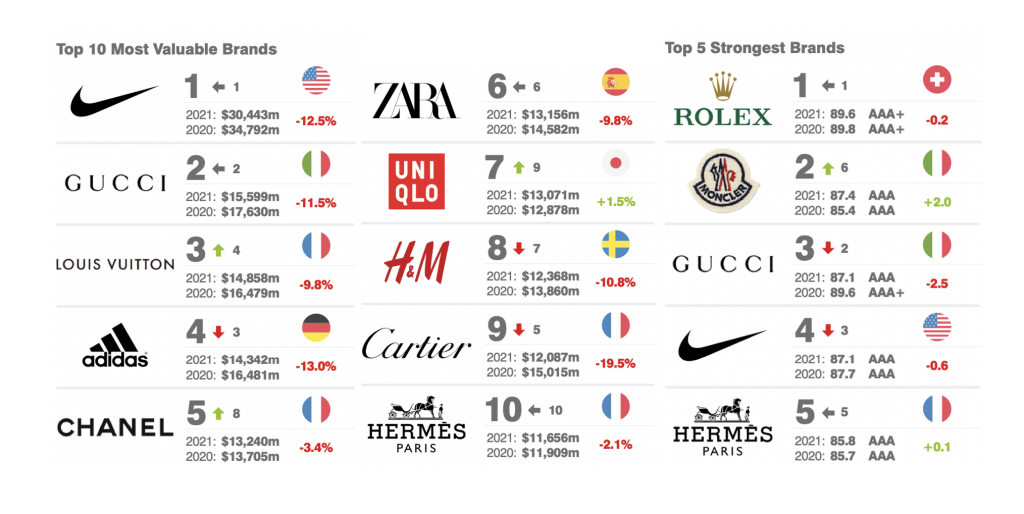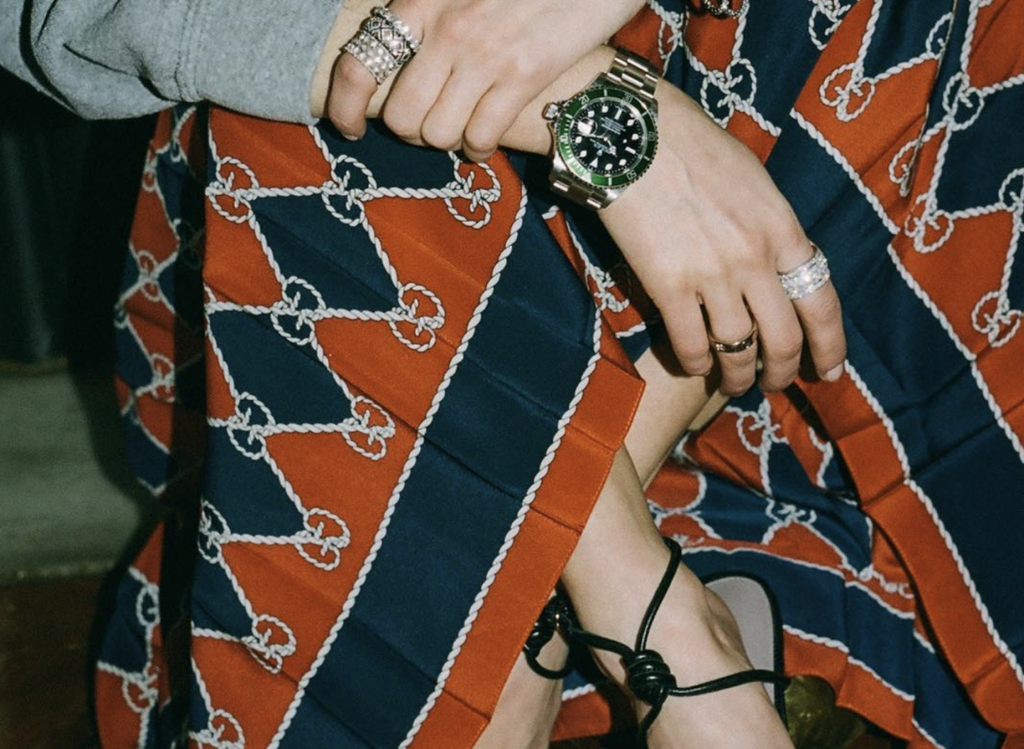In its latest brand valuation ranking, Brand Finance focuses on the “world’s most valuable apparel companies,” with Nike taking the top spot on the list for the seventh year in a row. “Despite recording a 13 percent brand value drop to $30.4 billion” for 2021, Brand Finance found that the Beaverton, Oregon-based sportwear titan retained the number 1 spot, due in part to its continued pattern of introducing “new technology in its products,” and maintained “a considerable lead over second-ranked Gucci,” which has a brand value of $15.6 billion, down 12 percent from 2020. Louis Vuitton, adidas, Chanel, Zara, Uniqlo, H&M, Cartier, and Hermès round out the rest of the top 10.
Breaking its “apparel” ranking down its various segments, including, “luxury; sportswear; fast fashion; watches, accessories and jewelry; high street designer; underwear; and footwear,” Brand Finance looks at the 5,000 “biggest brands” in these spaces, and ranks companies by “brand value,” a metric that it defines as “the value of the “names, terms, signs, symbols, logos, and designs” that a company uses to identify and distinguish its “goods, services or entities” from those of others, thereby creating “distinctive images and associations in the minds of stakeholders, and generating economic benefits” for the company as a result.”
While the total value of the world’s top 50 most valuable apparel brands as a whole declined by 8 percent, decreasing from $299.8 billion in 2020 to $276.4 billion in 2021, per Brand Finance’s calculations, as “global and widespread economic disruption caused a sharp decrease in demand and lockdown-induced store closures” further chipped away at companies’ bottom lines, not all sub-sectors and brands fared poorly. For instance, Brand Finance found that footwear “recorded an increase in brand value year-on-year, posting a 9 percent rise in brand value on average,” and new entrants, such as Timberland and Converse, “performed particularly well, recording a 47 percent and 48 percent brand value increase, respectively.”

Among the companies that exhibited the greatest growth in brand value on a year-over-year basis, sportswear brand Fila topped the list, with 68.4 percent growth between 2020 and 2021. “Since Fila Korea purchased the global Fila brand in 2007, the brand has worked on strategically embracing the return of trends which helped it make its name across the sector originally, including 90s fashion making several comebacks,” Brand Finance asserted. In terms of brand value growth, Fila is followed by Puma (25.9 percent), Dior (13.9), jewelry company Pandora (12.9 percent), and Lululemon (12.9 percent). Down a bit further on the list, Giorgio Armani, which is in the midst of an upmarket move, logged a 6.9 percent change in brand value.
On the flip side, Brand Finance found that Coach saw the greatest drop in brand value, down 30.7 percent on a year-over-year basis, as its “sales and profits have taken a hit over the previous year.” Burberry similarly fell by Band Finance’s figures, down 25.7 percent, as did Victoria’s Secret (down 21.8 percent), Hugo Boss (down 21.5 percent), Prada (down 21.4 percent), Under Armour (down 19.7 percent), and Cartier (down 19.5 percent).
In addition to brand value, Brand Finance also judges companies by their “Brand Strength,” which takes into account a company’s “marketing investment, customer familiarity, staff satisfaction, and corporate reputation.” On this front, Rolex came out on top again this year, with a Brand Strength Index score of 89.6 out of 100 and a corresponding elite AAA+ brand strength rating. “Synonymous with timeless class and luxury, Rolex is renowned for its world-leading quality and exclusivity, with the brand’s new releases known for setting the standard across the watch sector,” the report states. “Despite the challenges of the last year, the market for luxury watches has shown remarkable resilience to the pandemic turmoil, with demand remaining stable, demonstrated by Rolex’s website traffic experiencing a surge over the previous year.”
Also in the “Brand Strength” top 5: Moncler, which landed in the number 2 positing after advancing 6 spots from last year. The rise in ranking for Moncler comes as the Remo Ruffini-run brand has been experiencing “strong momentum” over the past year, according to a recent Bernstein report. Meanwhile, Gucci took the number 3 spot, down 3 places from last year; Nike came in at number 4, also down three spots; and Hermès again took the number 5 spot this year.
As for the significance of its “Brand Value” and “Brand Strength” metrics, Brand Finance has consistently held that “the most fundamental reason to conduct these valuation analyses is to find out how brands – that is, trademarks and their associated intellectual property – improve the financial performance of a business,” which brands accomplish “by impacting the perceptions that customers, employees and other relevant stakeholders.” The consultancy claims that as a result of its various ranking exercises, it has found that brand-specific elements and assets “consistently make up 20 to 25 percent of the value of listed companies.” Though, Brand Finance cautions that this figure differs by “type of business, industry, segment, stage of life and many other factors.”











